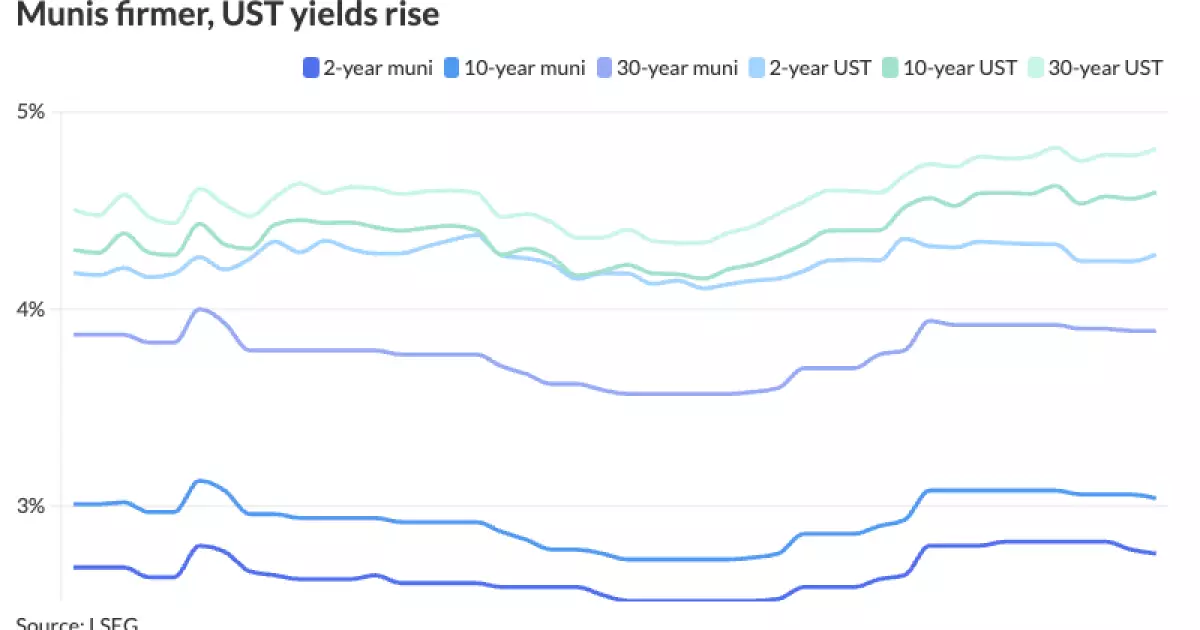As we embark on the New Year, the municipal bond market is reflecting an intricate interplay of factors resulting in firm yields and investor sentiment. On one hand, a new issuance of over $5 billion is set to hit the market, and on the other, U.S. Treasuries are witnessing slight losses amid gains in equities. The larger narrative here is shaped by fluctuating yield curves and the dynamics of demand and supply, which set the stage for how investors will navigate the waters in this evolving financial landscape.
Last week’s market dynamics illustrated a tangible disparity between municipal bonds and U.S. Treasuries. With triple-A municipal yields declining by up to seven basis points while the UST yields increased by a marginal two to four basis points, a notable trend emerged—investors are finding more attractive yields within the municipal sector, despite historically high valuations relative to Treasuries. Mikhail Foux, Barclays’ managing director, observes that the potential for subdued new issuances could bolster demand for munis moving forward.
The average yield across various tenors exhibited a dramatic shift, with December seeing municipal yields rise by an average of 37 basis points, particularly pronounced in the 15-20 year range. Despite the allure of these rates, Jason Wong from AmeriVet Securities cautions that munis remain historically expensive, a sentiment echoed by many market watchers who are reticent about whether the current attractiveness will sustain.
The upcoming weeks promise to be pivotal as the municipal market braces for approximately $5.18 billion in new supply. The calendar features significant issues, including a hefty $1 billion worth of energy revenue bonds from the Southeast Energy Authority and $850 million from the San Diego Community College District. The expectation is that this influx of supply could serve to recalibrate market plays, especially with heavy redemptions expected over the month.
Pat Luby from CreditSights pointed out that while January’s redemptions are forecasted to drop by 25% compared to December, the demand from coupon payments—totalling upwards of $16.3 billion—will still inject considerable liquidity into the marketplace. The timing cannot be understated, especially given that major economic indicators will be released in this timeframe, which could subtly sway issuer behavior.
Investor activity presents a mixed picture, with municipal mutual funds experiencing four consecutive weeks of outflows. While this trend is traditionally attributed to tax-loss harvesting at year-end, analysts anticipate the trend will likely reverse come January. Despite the setbacks, Foux expresses a cautious optimism, emphasizing the historical performance of munis during January—as equity volatility often introduces both opportunity and challenges.
The dichotomy of potential returns in January remains enigmatic; prior years have ranged from considerable gains to unexpected losses. Foux highlighted the average return during this month has been merely 0.4% over the past decade, underscoring the necessity for astute investment strategies amid a landscape continually shaped by policy changes and market sentiment.
The prospect of a new U.S. administration and its potential tax policies on municipal bonds is a looming concern for investors, with Wong indicating that this uncertainty could affect overall supply. The Federal Reserve’s stance on monetary policy remains another critical factor in navigating the municipal bond environment. With inflation control and a resilient labor market at the forefront, the Fed’s cautious approach is poised to keep stakeholders guessing.
Current expectations from the Fed indicate a possible pause in tightening during Q1, which could create a more cautious atmosphere among bond issuers. Consequently, this tension between monetary policy and bond performance will require investors to maintain a flexible approach to portfolio management.
The municipal bond market stands at a crossroads as it enters 2025. With relatively cheapened yields compared to Treasuries, a substantial issuance ahead, and the overarching influence of economic data, investors face a landscape ripe with opportunity but fraught with uncertainties. As we move deeper into January, market participants must remain vigilant, monitor the activity closely, and adapt their strategies as needed to effectively capitalize on emerging trends in the municipal bond space. The momentum established in the early weeks of the year could very well set the tone for the performance of munis throughout 2025, making it essential for all stakeholders to remain engaged and informed.

